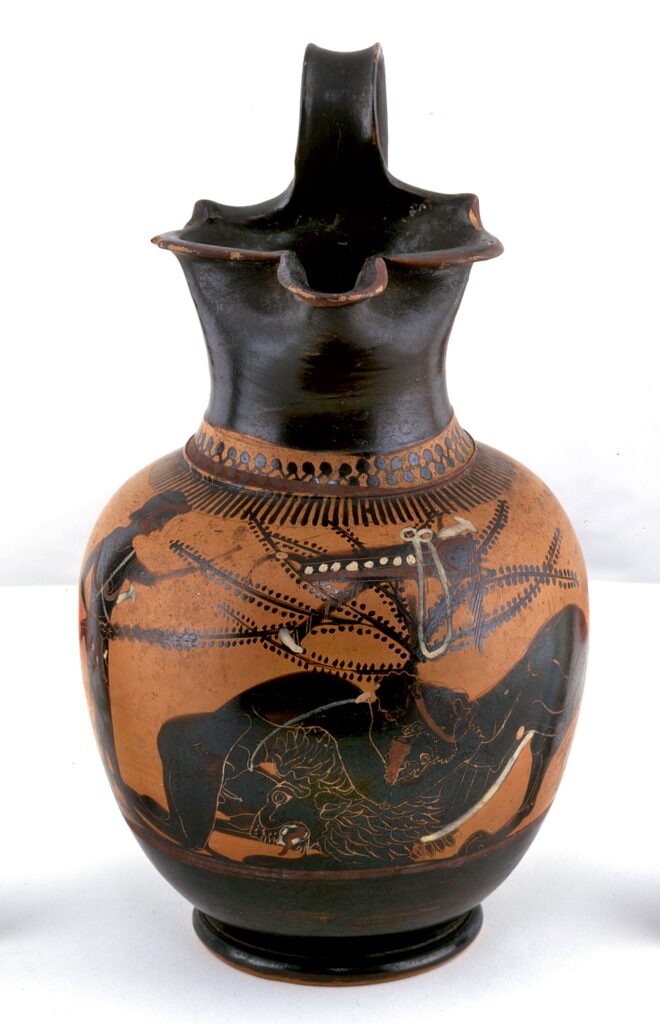
Artist: While listed as ‘anonymous,’ the time period from which this oinochoe was created allows us to imagine the techniques and styles used by the artist. A Greek poem, most likely composed in 6th century Athens, gives an amazing visual for pottery making during this time period:
If you pay me potters, I will sing:
Come here, Athena, and hold your hand over the kiln.
May the cups and bowls all turn out a good black,
May they be well fired, and fetch the price asked…
But if you turn shameless and deceitful,
Then I will summon the ravagers of kilns…
Stamp on the stoking tunnel and chambers, and may the whole kiln
Be thrown into confusion, while the potters cry aloud.
Great care was put into building the kiln, and pottery was seen as quite valuable. Black-figure vase painting was the earlier style utilized by Greek artists, as the materials were cheaper, but red-figure would soon take over. Many Attic vases show lighter painted lines that are raised from the surface, lines which added contour for clothing and anatomy. Instances of this technique can be seen in this oinochoe, with Heracles’ weapons in the tree and in the anatomy of the figures. It is also evident from this piece that the artist was skilled in their work, as the black gloss appears opaque and not a reddish-brown (Sparkes, Greek Pottery: An Introduction, 20-22).
Date: 550-500 BCE
Location: Blanton Museum of Art
Acquisition: This piece was brought to UT Austin by the Archer M. Huntington Museum Fund and the James R. Dougherty, Jr. Foundation in 1980. Archer Huntington dedicated his life to creating one of the world’s largest collections of Hispanic art and literature while the James R. Dougherty Jr. Foundation focused on creating collections of contemporary American and Texan art. This oinochoe from Attic Greece demonstrates a historical marker for pottery that adds to the timeline of techniques and styles used by artists.
Description: Athenian black-figure painting on an oinochoe (13.9 cm (5 1/2 in.) that depicts Heracles’ first labor: the Nemean Labor. A defining theme in the artwork of the demigod, Heracles, is that of his twelve labors.
Born from the affair of Zeus and Alkmene, the myth of Heracles finds its genesis in his pathos driven by the anger of Hera. Such is where we get his namesake, “Fame from Hera.” Driven by jealousy and hatred, Hera cursed Heracles with madness, causing him the kill his wife, Megara, and his children. To atone for his wrongdoings, Eurystheus, ruler of all the Argolid, instructed Heracles to complete a series of Labors that would prove his strength and virtue (Buxton, The Complete World of Greek Mythology, 114-115).
The first labor, the Nemean Lion, hinted at the strength and cleverness of the Greek hero Heracles. On the oinochoe, weapons are depicted hanging from the tree, reminding the viewer that Heracles fought the Nemean lion with his bare hands. In On Heracles, written in the late 5h-early 4th c. BC, Herodorus attempts to rationalize the true meaning of the myth of Heracles through allegory. The lion is a noble animal, and with the skin of the Nemean lion wrapped around him, Heracles is noted as a noble hero. Herodorus also mentions Heracles’ iconic club as a symbol for philosophy (Herodorus, On Heracles, 14). This club is also depicted on the oinochoe, being held over the head of Heracles by his son Iolaos as a gesture of assistance.
An oinochoe is a vessel for wine, one which would’ve been used in a Greek symposium. These ‘drinking parties’ were dominated by the men of the society, and it is where we often see instances of pederasty. The relationship between the Greek eromenos and erastes was often used for mentorship and even political preferment (Ludwig, Eros and Polis: Desire and Community in Greek Political Theory, 30). The depiction of Heracles on the oinochoe could therefore reinstate the power of men in the society and the importance of mentorship and filial piety seen in the inclusion of Iolaos in the piece. The defeat of the Nemean Lion is the pinnacle of male strength in the perspective of Ancient Greece, and the use of such a scene with the respect to the Greek symposium emphasizes the importance of patriarchy in the Greek society.
Sources:
Buxton, R. G. A. The Complete World of Greek Mythology. London: Thames & Hudson, 2016.
Ludwig, Paul W. Eros and Polis: Desire and Community in Greek Political Theory. Cambridge: Cambridge University Press, 2006.
Sparkes, Brian A. Greek Pottery: An Introduction. Manchester, England: Manchester University Press, 1991.
Trzaskoma, Stephen, R. Scott Smith, Stephen Brunet, and Thomas G. Palaima. Anthology of Classical Myth: Primary Sources in Translation. Indianapolis, IN: Hackett Publishing, 2004

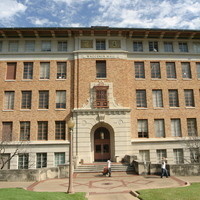

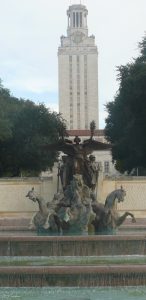
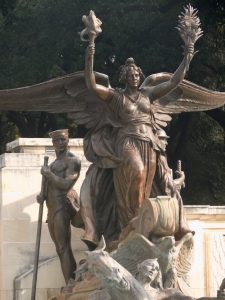
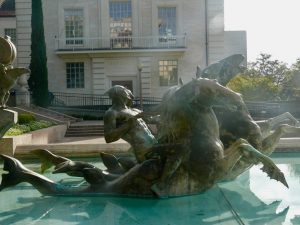


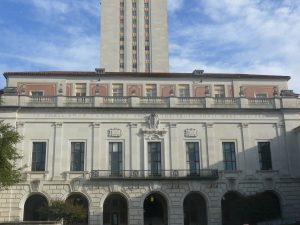


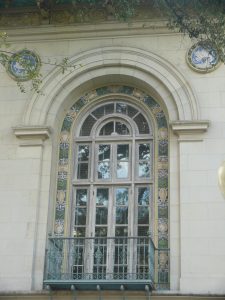
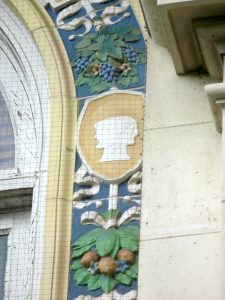
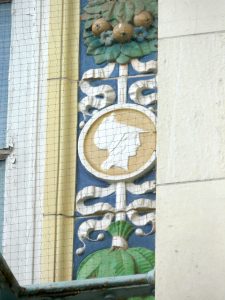

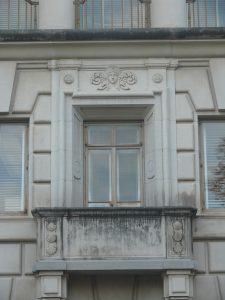

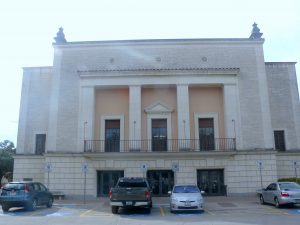
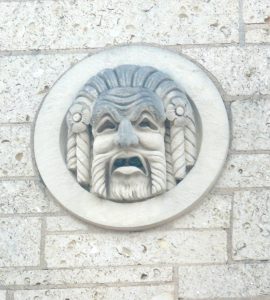 Although Greek drama, particularly tragedies, were often set in the heroic world of Greek myth, they were used as a way of investigating contemporary Greek issues. Many of the narratives of Greek myth that are preserved in the writings of mythographers are based on the dramatic tellings of Greek myths by Athenian tragedians, such as Aeschylus, Sophocles, and Euripides. In Greek myth, the dramatic arts of poetry, music, and dance were said to be inspired by female deities called
Although Greek drama, particularly tragedies, were often set in the heroic world of Greek myth, they were used as a way of investigating contemporary Greek issues. Many of the narratives of Greek myth that are preserved in the writings of mythographers are based on the dramatic tellings of Greek myths by Athenian tragedians, such as Aeschylus, Sophocles, and Euripides. In Greek myth, the dramatic arts of poetry, music, and dance were said to be inspired by female deities called  Greek comedies generally had far less to do with myth than the genres of Greek tragedy and satyr. The early Greek comedies were mainly satirical, mocking political figures and people of importance for their vanity and foolishness. Our primary example of comedy is from the playwright Aristophanes. One the few examples of Greek comedies with an extended treatment of characters in Greek myth is Aristophanes’ Frogs. Frogs tells the story of how the god Dionysus travels to the underworld to bring the tragedian Euripides back from the dead because of the poor quality of Athens’ living tragedians. The potential for irreverent depictions of the gods can be observed in the character of the god Dionysus, whose behavior and numerous errors along the way to the home of Hades provide the primary source of humor in this comedy.
Greek comedies generally had far less to do with myth than the genres of Greek tragedy and satyr. The early Greek comedies were mainly satirical, mocking political figures and people of importance for their vanity and foolishness. Our primary example of comedy is from the playwright Aristophanes. One the few examples of Greek comedies with an extended treatment of characters in Greek myth is Aristophanes’ Frogs. Frogs tells the story of how the god Dionysus travels to the underworld to bring the tragedian Euripides back from the dead because of the poor quality of Athens’ living tragedians. The potential for irreverent depictions of the gods can be observed in the character of the god Dionysus, whose behavior and numerous errors along the way to the home of Hades provide the primary source of humor in this comedy.

 I. Artist: The creator (sculptor) of the statue of Hera of Samos is unknown – the Blanton museum lists the creator as “Anonymous”. The inscription on the dress of the statue reads “Cheramyes dedicated me, a statue of Hera.” This implies that Cheramyes, an Greek aristocrat from Ionia, was the one who commissioned this piece as a monument to the
I. Artist: The creator (sculptor) of the statue of Hera of Samos is unknown – the Blanton museum lists the creator as “Anonymous”. The inscription on the dress of the statue reads “Cheramyes dedicated me, a statue of Hera.” This implies that Cheramyes, an Greek aristocrat from Ionia, was the one who commissioned this piece as a monument to the I. Architect: The Union building at the University of Texas was designed and completed by Robert L. White and Paul Cret. Paul Cret was an architect from Lyon, France that dedicated his work to design many famous public buildings across the United States. In nineteen thirty, Paul Crete was hired by the University of Texas as a consulting architect for a construction plan at the University, including the construction of the Union building, and continued to work at the University until his death fifteen years later. Some of his most notable works at the University of Texas include the Library on campus, the Architecture building, the Union building, the Home Economics building, the Littlefield memorial, the Yount House, the Texas Memorial Museum, and many dormitories on campus. Comparatively, Robert L. White was an architect from in Cooper, Texas. In nineteen twenty-one, White finished his bachelor’s degree in architecture at the University of Texas, and then came back to the University of Texas nine years later to obtain his master’s degree in architecture. While White was at the University of Texas attending graduate school for architecture, he became the supervising architect at the University of Texas. During this time, White was able to plan and execute many of the large building projects at the University of Texas during that were completed during the nineteen thirties, until his resignation twenty-eight years later. Some of his most famous constructions on campus include the Main Building, Goldsmith Hall, the Texas Union, and the Hogg Auditorium. Both Paul Crete and Robert L. White were important figures in the construction of the Union building and in the construction of many other important buildings on campus at the University of Texas.
I. Architect: The Union building at the University of Texas was designed and completed by Robert L. White and Paul Cret. Paul Cret was an architect from Lyon, France that dedicated his work to design many famous public buildings across the United States. In nineteen thirty, Paul Crete was hired by the University of Texas as a consulting architect for a construction plan at the University, including the construction of the Union building, and continued to work at the University until his death fifteen years later. Some of his most notable works at the University of Texas include the Library on campus, the Architecture building, the Union building, the Home Economics building, the Littlefield memorial, the Yount House, the Texas Memorial Museum, and many dormitories on campus. Comparatively, Robert L. White was an architect from in Cooper, Texas. In nineteen twenty-one, White finished his bachelor’s degree in architecture at the University of Texas, and then came back to the University of Texas nine years later to obtain his master’s degree in architecture. While White was at the University of Texas attending graduate school for architecture, he became the supervising architect at the University of Texas. During this time, White was able to plan and execute many of the large building projects at the University of Texas during that were completed during the nineteen thirties, until his resignation twenty-eight years later. Some of his most famous constructions on campus include the Main Building, Goldsmith Hall, the Texas Union, and the Hogg Auditorium. Both Paul Crete and Robert L. White were important figures in the construction of the Union building and in the construction of many other important buildings on campus at the University of Texas.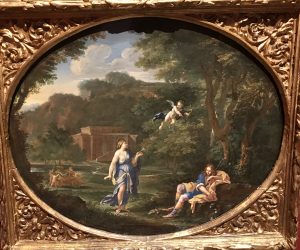 I. Artist: Venus and Adonis was painted by Filippo Lauri. Lauri lived from 1623-1694 in Italy, specifically in Rome. He was painting during the Baroque period, which is best described through opulence and grandeur. One thing that the art has in common during this Baroque period is that they involve drama. The drama can clearly be seen in Venus and Adonis because the work is meant to reflect the effects of love that can lead to despair. Lauri’s father was a Flemish landscape painter. Lauri studied painting under his father, then he studied under his brother, which led him to work for his brother-in-law. In 1654, Lauri became a member of the Accademia di San Luca in Rome. Lauri had many other well-known paints of Greek myth like Apollo Flaying Marsyas, but Lauri also had paintings regarding Christian ideals.
I. Artist: Venus and Adonis was painted by Filippo Lauri. Lauri lived from 1623-1694 in Italy, specifically in Rome. He was painting during the Baroque period, which is best described through opulence and grandeur. One thing that the art has in common during this Baroque period is that they involve drama. The drama can clearly be seen in Venus and Adonis because the work is meant to reflect the effects of love that can lead to despair. Lauri’s father was a Flemish landscape painter. Lauri studied painting under his father, then he studied under his brother, which led him to work for his brother-in-law. In 1654, Lauri became a member of the Accademia di San Luca in Rome. Lauri had many other well-known paints of Greek myth like Apollo Flaying Marsyas, but Lauri also had paintings regarding Christian ideals. I. Architect: The creation of this artwork is accredited to Paul Cret, who was the consulting architect responsible for the University of Texas Campus Master Plan and the design of the tower (Berry). Paul Cret was a French born architect who headed the architecture school at the University of Pennsylvania when he was hired to design the main building of the University of Texas campus (Nicar). Cret incorporated many aspects of Greek myth that held symbolic meaning for the university, including the head of Athena in order to accomplish his goal of making the building a meaningful and significant landmark at the University of Texas (Nicar).
I. Architect: The creation of this artwork is accredited to Paul Cret, who was the consulting architect responsible for the University of Texas Campus Master Plan and the design of the tower (Berry). Paul Cret was a French born architect who headed the architecture school at the University of Pennsylvania when he was hired to design the main building of the University of Texas campus (Nicar). Cret incorporated many aspects of Greek myth that held symbolic meaning for the university, including the head of Athena in order to accomplish his goal of making the building a meaningful and significant landmark at the University of Texas (Nicar). I. Architect: The statuettes on Sutton Hall were created by the architect Cass Gilbert. He was the campus architect for the University of Texas from 1909-1922 and also built Battle Hall and the Woolworth building. He was heavily inspired by the Mediterranean Renaissance style and built both Battle and Sutton Hall in reflection of it.
I. Architect: The statuettes on Sutton Hall were created by the architect Cass Gilbert. He was the campus architect for the University of Texas from 1909-1922 and also built Battle Hall and the Woolworth building. He was heavily inspired by the Mediterranean Renaissance style and built both Battle and Sutton Hall in reflection of it.
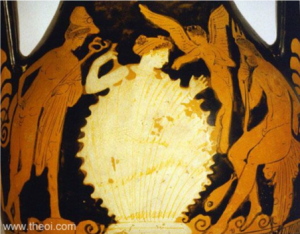
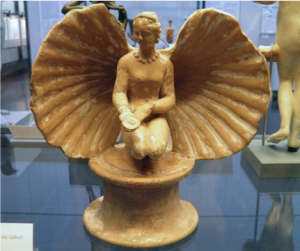
 I. Artist: The author of Quos Ego was Marcantonio Raimondi. Marcantonio was an engraver who was born close to Bologna, Italy in 1480 (Britannica 2019). He was highly skilled in his area of work, and this could possibly be credited to the person who trained him, Francia, who was a successful goldsmith as well as an extraordinary painter (Britannica 2019). Most of Raimondi’s best work was created when he started copying the works of Michaelangelo and Raphael (Britannica 2019). He was even fortunate enough to meet Raphael himself, who seemed to like Raimondi enough to insert him into his Explusion of Heliodorus (1513) (Britannica 2019). Raimondi’s connection to Raphael was his most important aspect when it came to his artwork. Some of Raimondi’s printings were Dream of Raphael (1507), The Climbers (1510), Massacre of the Innocents (1512-1513), and The Judgement of Paris (1510 – 1520). While many of Marcantonio Raimondi’s engravings were recreations, there was no doubt that the man was a wonderful artist.
I. Artist: The author of Quos Ego was Marcantonio Raimondi. Marcantonio was an engraver who was born close to Bologna, Italy in 1480 (Britannica 2019). He was highly skilled in his area of work, and this could possibly be credited to the person who trained him, Francia, who was a successful goldsmith as well as an extraordinary painter (Britannica 2019). Most of Raimondi’s best work was created when he started copying the works of Michaelangelo and Raphael (Britannica 2019). He was even fortunate enough to meet Raphael himself, who seemed to like Raimondi enough to insert him into his Explusion of Heliodorus (1513) (Britannica 2019). Raimondi’s connection to Raphael was his most important aspect when it came to his artwork. Some of Raimondi’s printings were Dream of Raphael (1507), The Climbers (1510), Massacre of the Innocents (1512-1513), and The Judgement of Paris (1510 – 1520). While many of Marcantonio Raimondi’s engravings were recreations, there was no doubt that the man was a wonderful artist.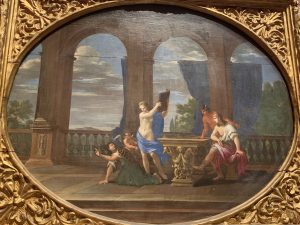 I. Artist: Filippo Lauri, born in 17th century Rome, was an artistic protégé who followed in the footsteps of his brother (Bryan, 1889, 25-26). Although having painted a small number of altar-pieces for churches, his most notable works involved those revolving around myth (Bryan, 1889, 25-26). Some important pieces comparable to those we have studied this year include “The Punishment of Marsyas,” “Venus and Adonis,” and “The Rape of Europa” among others (Bryan, 1889, 25-26). Lauri was also known for painting images that were housed in palaces around Rome (Blanton Museum of Art Collections, n.d.).
I. Artist: Filippo Lauri, born in 17th century Rome, was an artistic protégé who followed in the footsteps of his brother (Bryan, 1889, 25-26). Although having painted a small number of altar-pieces for churches, his most notable works involved those revolving around myth (Bryan, 1889, 25-26). Some important pieces comparable to those we have studied this year include “The Punishment of Marsyas,” “Venus and Adonis,” and “The Rape of Europa” among others (Bryan, 1889, 25-26). Lauri was also known for painting images that were housed in palaces around Rome (Blanton Museum of Art Collections, n.d.).